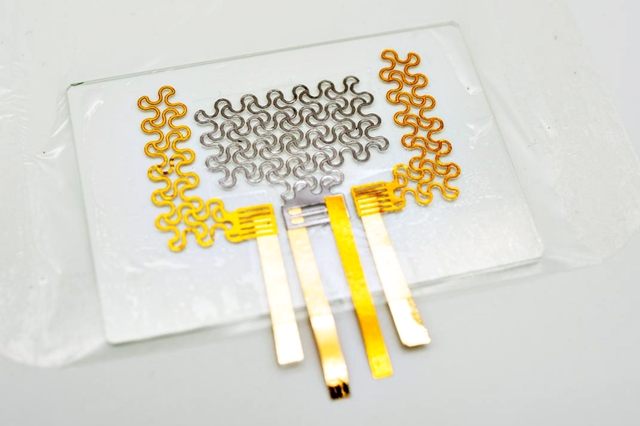21 June 2019. A bio-engineering lab created an ultra-thin, flexible plastic film, which when attached to the chest can monitor blood pressure over a period of time. Researchers from University of Texas in Austin describe their device and proof-of-concept tests in the 21 May issue of the journal Advanced Science.
A team from the lab of biomedical engineering and materials science professor Nanshu Lu is seeking more convenient ways for continuously monitoring vital signs like blood pressure. Hypertension, or high blood pressure, is a continuing public health problem affecting people in both genders and all ethnic groups, and increasingly at younger ages. Centers for Disease Control and Prevention says high blood pressure increases one’s risk of heart disease and stroke, and currently effects 75 million people, or one in three adults in the U.S.
Lu’s lab studies the use of electronics integrated with thin, flexible materials in wearable systems for health monitoring. For most people, measuring blood pressure is done at most periodically, if at all, and requires a visit to a clinic. Continuous monitoring of blood pressure and other heart-health indicators can provide a more complete picture of a person’s cardiovascular system and an earlier alert of problems.
The team’s solution is an ultra-thin clear plastic film with sensors to monitor physical and electrical heart signals. The film is made of polyvinylidene fluoride or PVDF, a clear polymer, with a special property needed for this device, the ability to generate electricity. PVDF is piezoelectric, which means it produces an electric current as a result of movement or stress. This quality allows the Texas team’s device to be self-powered, eliminating the need for a separate power source, keeping it very thin and worn like a stick-on tattoo.
The researchers printed an electronic sensor with gold electrodes on the PVDF film measuring electrical signals from the heart, much like an electrocardiogram. But the device also has a similar sensor to measure vibrations made by the chest each time the heart beats. The researchers say it is the first flexible and wearable device to incorporate monitor both electric signals and vibrations from the heart. Lu notes in a university statement, “We can get much greater insight into heart health by the synchronous collection of data from both sources.”
The team also devised a technique using digital image correlation to locate the optimum location on the chest to place the tattoo device. Digital image correlation calculates contour, deformation, vibration, and strain on a surface, in this case to determine the best point on the chest to measure vibrations from heart beats, as well as capture electrical signals.
The researchers tested a prototype device with four volunteers. The tattoo systems provided data on the volunteers’ heart signals and vibrations that allowed the team to calculate timing intervals from their hearts, including systolic time interval, a measure of pumping ability. With systolic time intervals, the authors estimated the volunteers’ blood pressure, a measure correlated with systolic time interval.
The team believes a device like their electronic tattoo can eventually replace bulky systems like Holter monitors for tracking cardiac performance. The researchers still need to add communications functions, such as Bluetooth, to the device, but the lab is already working on a smartphone app that stores data from the device and illustrates the heart beating in real time.
More from Science & Enterprise:


 RSS - Posts
RSS - Posts
You must be logged in to post a comment.